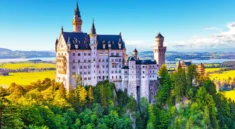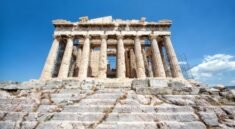
Some cities shine because they are new—gleaming skyscrapers, cutting-edge technology, and neon-lit streets that pulse with energy. Others capture the imagination through their age—stone ruins, weathered temples, and timeworn monuments whispering the stories of long-gone civilizations. But a rare few offer something truly extraordinary: a harmonious blend where ancient ruins and modern life coexist side by side. These cities are living museums, where past and present intertwine so gracefully that time seems to pause, and every street becomes a dialogue between history and now.
One such timeless city—a shining example of this coexistence—is Rome, Italy. Known as the “Eternal City,” Rome is a testament to the resilience of culture and the endurance of beauty. Here, you can sip an espresso on a bustling piazza with a view of a 2,000-year-old amphitheater. You can shop in chic boutiques tucked inside Renaissance buildings. You can walk on cobblestones where emperors once strolled, while traffic lights guide Vespas and Fiats around you. This unique layering of eras makes Rome, and cities like it, not only fascinating travel destinations but soulful experiences that leave a deep and lasting impression.
Let’s explore this captivating duality—where ancient ruins stand proudly amid modern life, creating a cityscape unlike any other.
Echoes of Empire: Ancient Wonders Around Every Corner
Step into the historic heart of this timeless city, and you’re immediately surrounded by echoes of a bygone empire. The Roman Forum, once the center of political and social life, now lies in poetic ruin. Columns rise like sentinels, marble blocks lie in elegant disorder, and archways still display intricate carvings from centuries past.
Nearby, the Colosseum stands as a colossal reminder of Rome’s grandeur. Despite earthquakes, looting, and pollution, it has endured as an iconic emblem of Roman engineering and spectacle. Today, it welcomes millions of visitors who come to marvel at its size, symmetry, and symbolism. But even as tourists wander through its arched corridors, modern life hums just outside—cafés serving gelato, taxis honking, and locals on their phones rushing to meetings.
Rome’s ruins are not confined to museums. They are part of daily life. The Pantheon, with its awe-inspiring oculus, still functions as a church. The Aventine Keyhole, through which you can see a perfectly framed view of St. Peter’s Basilica, is a well-kept local secret. Even apartment complexes and metro stations have been built around ruins, carefully preserving them rather than erasing them.
This effortless blend allows visitors to feel that history is not locked away, but actively lived.
Life Among the Ruins: A Modern City in Motion
While ancient stones tell stories of emperors and gladiators, the modern city buzzes with life and culture. Rome today is a thriving European capital, filled with world-class cuisine, fashion, art, and innovation. It’s a place where locals live with history—not as a relic, but as a backdrop to their daily routines.
Modern Romans are fiercely proud of their heritage, yet fully engaged in the present. Young professionals sip Aperol spritzes in trendy rooftop bars with panoramic views of ancient monuments. Families gather in public squares for evening strolls, surrounded by architecture that predates their ancestors by millennia. And the latest Italian fashion can be found just steps from archaeological wonders.
Technology and tradition coexist too. Digital tour guides walk visitors through ruins with augmented reality. Wi-Fi is readily available in ancient piazzas. And apps help you navigate the city’s layered history as easily as finding the best pasta in town.
This fusion creates a kind of energy unique to Rome—one where the past is honored, but not frozen; celebrated, but not commodified. It lives, breathes, and evolves with the city itself.
Art, Religion, and Architecture: Layers of Cultural Legacy
What makes this timeless city even more exceptional is the continuity of creativity across centuries. While ancient Rome built aqueducts and arenas, medieval Rome gave us basilicas and mosaics. The Renaissance added grandeur and refinement, and the Baroque period crowned the city with fountains and domes.
Walk into St. Peter’s Basilica, and you witness a confluence of artistry that spans ages—from Michelangelo’s Pietà to Bernini’s altar. Nearby, the Vatican Museums hold an overwhelming collection of masterpieces, including the Sistine Chapel, where every square inch tells a story of divine imagination.
Yet even outside the Vatican walls, Rome is an open-air gallery. Every street corner features a church, a statue, or a fountain. Modern artists and musicians add their voices, performing in public squares or painting murals on quiet backstreets. Galleries display contemporary pieces in settings that once housed imperial art.
The city is, in essence, an evolving masterpiece, where ancient carvings and futuristic installations are merely different strokes on the same canvas.
Culinary Traditions: Ancient Flavors with Modern Flair
Just as Rome’s architecture bridges eras, so does its cuisine. Traditional Roman dishes—like cacio e pepe, carbonara, and supplì—have roots in ancient culinary practices. The use of simple, fresh ingredients and rustic techniques reflect a lineage stretching back to the time of the Caesars.
But Rome’s food scene is far from static. Modern chefs reinterpret classic dishes with bold creativity. You’ll find gourmet versions of peasant recipes, fusion dishes that blend Italian with Asian or Middle Eastern flavors, and vegan takes on age-old pasta favorites. Roman markets, like Campo de’ Fiori and Testaccio, offer the freshest produce alongside artisanal cheeses and cured meats that continue ancient traditions of fermentation and aging.
Even the act of dining feels timeless. Meals in Rome are experiences—unhurried, communal, filled with conversation and laughter. Whether in a centuries-old trattoria or a sleek modern restaurant, food is a bridge between past and present, tradition and innovation.
Festivals, Rituals, and the Rhythm of Roman Life
Rome’s cultural calendar reflects its rich and layered identity. Religious festivals like Easter at the Vatican attract pilgrims from across the world, while La Festa della Repubblica celebrates modern Italy’s democratic birth. Historical reenactments at the Colosseum, art exhibitions in Renaissance palaces, and outdoor film screenings in ancient ruins all speak to the city’s vibrant and inclusive spirit.
Daily life, too, follows a rhythm shaped by centuries of practice. The passeggiata—an evening stroll—remains a beloved ritual. So does the morning espresso at the bar, taken standing, just like generations before.
Rome encourages its citizens and visitors to slow down and savor. The city moves at a different pace, one that invites contemplation, appreciation, and connection.
Preserving the Past While Building the Future
Balancing ancient heritage with modern demands is no easy task. Yet Rome has made concerted efforts to preserve its history without hindering growth. Archaeological projects uncover more treasures every year, while sustainable tourism initiatives aim to protect fragile sites.
Modern infrastructure projects, like expanding the metro or renovating transport hubs, are done with care and consultation. Often, construction delays happen not because of inefficiency, but because new ruins are discovered, halting progress so that history can be studied and saved.
This shows a rare respect for the past—a recognition that even while cities must grow, they must also remember.
The Emotional Resonance of Timelessness
More than its ruins or its restaurants, what makes this city timeless is its emotional impact. It’s the feeling of touching marble smoothed by centuries of hands. Of hearing church bells echo through narrow alleys. Of watching the sun set behind ancient domes while modern life bustles all around you.
Rome, and cities like it, remind us of our place in the continuum of time. They allow us to walk with the ancients, to dine with the present, and to dream with the future. They teach us that while empires may fall, beauty and meaning endure.
Conclusion: A Journey Through Time, Alive in the Present
In a world rushing toward the future, the timeless city stands still—and yet it is never frozen. It grows, it adapts, but it does not forget. It offers travelers more than sights to see; it offers a chance to live inside history, if only for a moment.
To visit this kind of city is to experience a dialogue between centuries—a gentle conversation between columns and cafés, between ruins and routines, between emperors and entrepreneurs. It is a place where every brick tells a story, every step retraces time, and every glance reveals the layered wonder of civilization.
So come, and walk its ancient paths. Dine where gladiators once feasted, and where politicians now debate. Look up at the same stars that watched over emperors and artists. In this timeless city, the past and present don’t just meet—they thrive together.
And in doing so, they create a place not just to visit—but to remember, forever.




